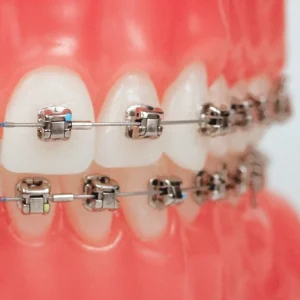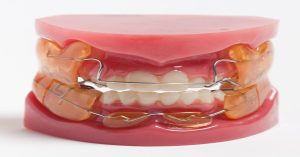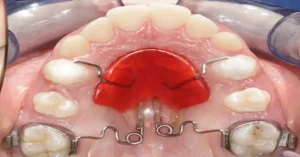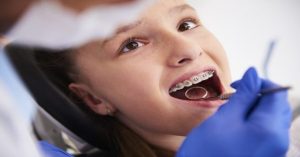- ✨ The American Association of Orthodontists (AAO) recommends children visit an orthodontist by age 7.
- ✨ By age 7, children typically have a combination of baby (milk) and permanent teeth.
- ✨ This provides sufficient data to evaluate how the jaw and teeth are developi.
Parents often ask, “Is my child too young—or too old—for braces?” While there is an ideal window for assessment, modern orthodontics ensures that nearly every age group benefits from treatment. Whether you’re nurturing a child’s dental development, supporting a teen’s smile journey, or seeking orthodontic care as an adult, the path to healthy teeth is open—no matter your stage in life.
Timing is key, but it’s never too late. At AQR Orthodontics in Dubai, Dr. AQR and our team champion personalised care tailored to your specific needs, growth, and unique smile goals.
What is the best age for Orthodontic treatment?
The American Association of Orthodontists (AAO) recommends children visit an orthodontist by age 7—even if braces aren’t immediate. This is because:
- Mixed Dentition Stage: By age 7, children typically have a combination of baby (milk) and permanent teeth, providing orthodontists with sufficient data to evaluate how the jaw and teeth are developing.
- Early Spotting of Subtle Issues: While major problems are easy to see, orthodontists are trained to detect milder issues—like a slight shift in jaw midline, unerupted adult teeth, or early crowding—which otherwise could worsen.
- Strategic Monitoring: If no immediate treatment is needed, periodic “watchful waiting” helps ensure intervention happens just in time to leverage growth spurts.
Triple Outcome from a Visit at 7 Years Of Age and What to Expect?
When your child visits an orthodontist at around 7 years old, it’s not just about getting braces—it’s about making informed choices for their dental future. Here’s how that first visit can guide treatment:
No Immediate Treatment Needed
- The orthodontist may determine that your child’s jaw and teeth are developing normally. In such cases, no active treatment is required, only routine check-ups to monitor growth.
- This “watchful waiting” ensures you stay ahead of any changes, intervening precisely when necessary.
Scheduled for Future Full-Phase Treatment
- If there’s concern about delayed eruption, crowding, or bite issues, the orthodontist can plan for full-phase treatment later—typically when most permanent teeth have emerged (ages 11–16).
- This preemptive strategy ensures treatment begins at the optimal moment, reducing the risk of emergency interventions.
Phase One (Interceptive) Intervention Recommendations
- Some cases benefit from early Phase One treatment, which can use devices—or partial braces—to guide jaw growth, correct crossbites, or address protruding teeth before problems worsen.
- Interceptive care often simplifies and shortens full-phase orthodontics later.
Bottom line? A consultation by age 7 empowers orthodontists to either confirm healthy development, prepare for future treatment, or apply targeted early interventions—laying the groundwork for healthier smiles and avoiding more invasive procedures down the road.
Phase One Orthodontics (Ages 7–10): Intercepting Problems Before They Escalate
Interceptive, or Phase One, treatment occurs while a child still has some baby teeth. Goals include:
- Guiding Jaw Growth: Appliances like palatal expanders shape the jaws, making space for erupting adult teeth and often avoiding extractions.
- Fixing Cross Bites Early: Untreated cross bites can lead to skewed facial development and asymmetry—but early correction ensures balanced jaw growth.
- Protecting Protruding Teeth: Children with “buck teeth” are at higher risk for injuries; aligning them early reduces that risk significantly.
- Breaking Harmful Oral Habits: Devices like habit breakers gently discourage thumb-sucking or tongue thrusting that impact bite formation.
- Simplifying Future Treatment: The second phase (full braces) is typically gentler and quicker because many issues were already addressed.
- Common Phase One appliances
- Palatal expanders
- Partial braces
- Habit-breaking devices
- Space maintainers
Phase One doesn’t guarantee full treatment, but it ensures later orthodontic care is more effective and less invasive.
Phase Two Orthodontics (Ages 11–16): Aligning the Teenage Smile
During adolescence, most permanent teeth are in place, and jaw growth is still active—making this the classic time for comprehensive treatment.
Why It’s Ideal for Teens?
- Strong Motivation: Self-consciousness about appearance encourages cooperation during treatment.
- Growth-Responsive: Younger bone and tooth movement respond more efficiently, shortening treatment time.
- Treatment Variety: Options including metal or ceramic braces or clear aligners (like Invisalign) can meet aesthetic and lifestyle needs.
What to Expect?
- Digital scans and models to design a custom appliance.
- Regular adjustments every 4–8 weeks.
- Duration is typically 18–24 months.
- Finishing with retainers to lock in results.
Between ages 11 and 16, orthodontic treatment can both correct bite issues and create a confident, healthy smile that lasts into adulthood.
Adult Orthodontics (Ages 18+): It’s Never Too Late for a Smile Makeover
Adult orthodontic patients are on the rise—and increasingly visible in clinics across Dubai.
Why Adults Opt for Treatment?
- Unfinished Childhood Needs: Many never had braces, or teeth have shifted over time.
- Relapse after Removable Retainers: Without consistent retainer wear, teeth can drift—a common reason for adult treatments.
- New Dental Concerns: Issues like spacing, bite adjustments, or TMJ discomfort often emerge later in life.
- Boosting Aesthetics & Function: More adults are improving not just their looks, but also oral hygiene, chewing, and speech.
- Preparation for Dentistry: Orthodontic alignment sets the stage for effective implants, crowns, or veneers.
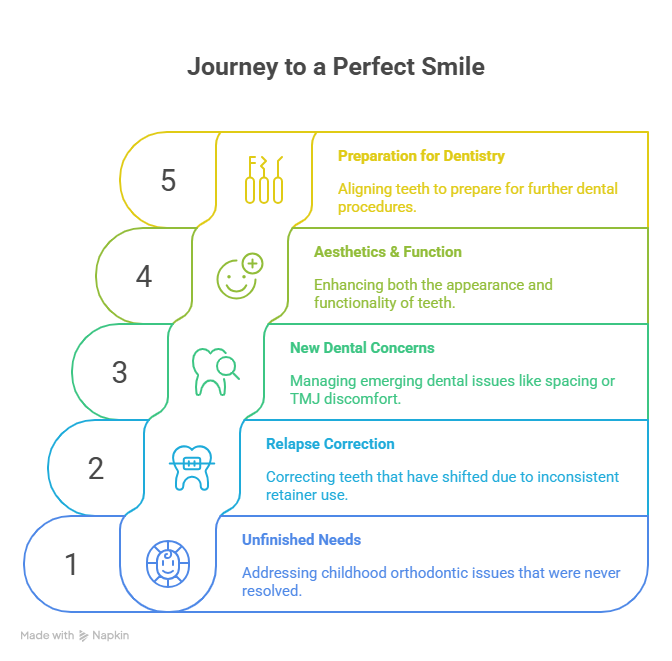
What Adults Should Know?
- Fully Mature Jaw: Tooth movement may be slower, but results are equally robust.
- Discreet Treatment: Clear aligners, lingual braces, and ceramic options cater to adult aesthetics.
- Existing Dental Health: Our evaluation addresses gum health, restorations, or missing teeth for safe, integrated planning.
Despite being past growth years, adults gain huge benefits—from better oral health to improved confidence—all while getting exceptional care at AQR Orthodontics.
So, when is the best time to start orthodontic treatment?
Babies & Pre-schoolers
No special orthodontic assessment is needed unless issues are visible, like difficulty chewing, mouth-breathing, or persistent thumb-sucking, but early dental check-ups are still important.
Ages 3–6
Dental visits should monitor baby teeth; orthodontic screenings are typically not needed unless clear problems (e.g., crossbite) are present.
Age 7
Ideal time for the first orthodontic evaluation per AAO—including digital scans and x-rays—to detect early conditions.
Ages 7–10
Phase One intervention recommended for intercepting growth-related issues.
Ages 11–16
Phase Two treatment aligns the full permanent dentition and balances jaw growth and aesthetics.
Ages 18+
Adult treatment tailored to health, bite correction, and cosmetic goals for long-term dental success.
Why Timing Matters: The Power of Early Intervention
- Growth Guidance: Early braces shape jaw development for better alignment and facial symmetry.
- Cost Efficiency: Intercepting issues early prevents expensive interventions, surgery, or extractions later.
- Treatment Simplification: Taking early action reduces the time and complexity of second-phase therapy.
- Dental & Functional Benefits: Addressing alignment improves oral hygiene, speech, and chewing, and reduces risk of decay or TMJ issues.
- Emotional Confidence: Children who begin treatment early enjoy healthier self-esteem and peer interactions.
Why Choose AQR Orthodontics in Dubai?
- Expert Guidance Across Ages: From early interceptive care to adult orthodontics, Dr. AQR designs treatment tailored to your stage of life.
- State-of-the-Art Technology: We use digital 3D scans, X-rays, and virtual simulations to craft precise, effective plans.
- Discreet & Comfortable Choices: Services include metal & ceramic braces, lingual braces, and Invisalign clear aligners—perfectly suited to busy adult life.
- Holistic Approach: We proactively address growth, dental health, and lifestyle considerations in every treatment.
- Flexible Financial Plans: Transparent treatment estimates and financing options help families invest in orthodontic care with ease.
- Supportive Environment: Our team in Jumeirah creates a welcoming, patient-centred atmosphere for all ages.
Ready to start your smile journey?
It’s never too early—or too late—to invest in a healthier, more confident smile. If you’re a parent, consider booking a complimentary orthodontic consultation—especially before your child turns seven—to gain expert guidance on dental development. Teens and adults thinking about straighter teeth, improved bite function, or addressing health concerns will also benefit from exploring all available treatment options.
Reach out to AQR Orthodontics, located in Jumeirah, Dubai, today to schedule a full smile evaluation with Dr. AQR. Let us partner with you, regardless of age on your journey to optimal oral health and lasting smile confidence.



